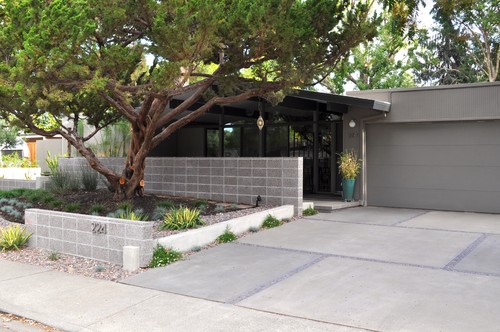There are two certainties in terms of concrete. It will strengthen and it invariably will crack. Actually, cracking is the most frequent causes of complaints regarding concrete.

Photo by Huettl Landscape Architecture – Browse landscaping photos
Concrete cracks for many reasons but usually cracking is the result of a combination of factors such as thermal contraction, drying shrinkage, applied loads, restraint (internal or external) to shortening and subgrade settlement.
However, cracking of the concrete cannot be prevented but at least this process can be controlled and reduced.
A Smart Solution for Every Surface – Concrete Concrete (howtobuildahouseblog.com)
How to Minimize Cracking in Concrete Floors or Slabs
a| Plastic – Shrinkage Cracks:
Usually, cracks that occur in concrete floors or slabs are plastic-shrinkage cracks and they are caused by loss of the water when the concrete is not cured yet.
This is caused by rapid evaporation of water and generally occurs before concrete surface final finishing on dried and windy days. Obviously, concrete surface moisture will evaporate fast and the water that rises within the concrete can replace it quickly.
Plastic-shrinkage cracks are of different sizes between few inches or centimeters and almost 10 feet or 3meters. You can easily prevent these cracks covering the concrete surface with plastic sheets or spraying water over it to replace the lost water. Also, you can use a spray-applied finishing aid to prevent the rapid loss of concrete surface moisture.
b| Drying Shrinkage, Thermal Contraction Cracks:
These types of cracks occur after concrete hardening. In the hardening process, concrete shrinks at least 1/16 in. to a length of 10ft.
Using construction joints (concrete control joints) can prevent these cracks. They are used usually, to minimize cracking in concrete floors and slabs. You need to properly place and install these concrete control joints to minimize concrete cracking. Properly placed concrete control joints allow concrete to expand, shrink or contract freely, reducing its tendency to crack.
If you want to minimize the possibility of cracking, it is critical to plan in advance where and what kind of materials you will need to install your concrete control joints. It is extremely important that you do not skip these important preparatory steps.
There are three types of concrete control joints:
1| Concrete Construction Joints – They are made of steel, plastic (plastic bulkhead) or wood. Their role is to minimize cracking in concrete slabs. It is a good and commonly used practice to bond and continue concrete reinforcement through a concrete construction joint.
– There are straight edged butt joints for light duty floors and slabs.
– There are dowels or key-ways for slabs with heavy traffic. Their role is to transfer the load from one slab to another slab.
2| Concrete Expansion Joints (or Concrete Isolation Joints) – Concrete is a construction material with an outstanding resistance to compression but with a low tensile strength. Therefore, concrete is prone to cracks when it is affected by certain stretching forces.
Concrete expansion joints or concrete isolation joints are designed to provide relief from these tensile stresses that can cause an uncontrolled cracking. They allow the concrete to move freely as it expands or shrinks.
They are installed to isolate and separate the concrete slab from other parts of your building such as walls, columns, piers or footings.
They are usually made of asphalt-impregnated fiber sheeting and you can cut easily them to the desired size. Another used material is ISO-strip-off, a compressible foam strip.
3| Concrete Contraction Joints – Their main role is creation of weakened plans in the concrete surface to help regulate and control random cracks that will occur.
In fact, concrete contraction joints are advanced-planned cracks made by tooling a joint or saw cutting in the concrete.


